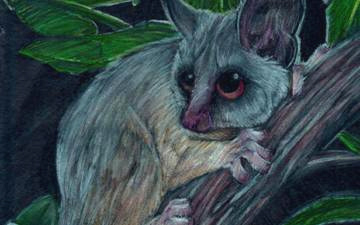The Senegal Bushbaby (Galago senegalensis), also known as the Senegal Galago, the Lesser Galago or the Lesser Bush Baby, is a small, nocturnal primate, a member of the galago family Galagidae.
The name “bush baby” may come either from the animals’ cries or from their appearance. They are agile leapers, and run swiftly along branches. They live in Africa south of the Sahara and nearby islands including Zanzibar. They tend to live in dry woodland regions and savannah regions. They are small primates (130mm and 95-300 grams) with woolly thick fur that ranges from silvery grey to dark brown. They have large eyes, giving them good night vision; strong hind limbs; and long tails, which help them balance. Their ears are made up of four segments that can bend back individually, to aid their hearing when hunting insects at night. Their omnivorous diet is a mixture of insects and other small animals including birds and insects, fruit, seeds, flowers, eggs, nuts, and tree gums.
Bushbabies reproduce twice a year, at the beginning of the rains (November) and the end (February). They are polygynous, and the females raise their young in nests made from leaves. They have 1-2 babies per litter, with gestation period being 110-120 days. Bush babies are born with half-closed eyes, unable to move about independently. After a few days, the mother carries the infant in her mouth, and leaves it on convenient branches while feeding.
(From Wikipedia, August 17th, 2010)
—
Average length of Galago senegalensis is 130 mm. Tail length varies between 15 and 41 mm. Members of the genus weigh between 95 and 300 g.
Galago sensgalensis has thick, woolly, rather long and wavy fur which is silvery gray to brown dorsally and slightly lighter underneath. Ears are large, with four transverse ridges that can be independently or simultaneously bent back and wrinkled downward from the tips toward the base. The ends of the fingers and toes have flat disks of thickened skin, which aid in grasping tree limbs and slippery surfaces. Their tongues have a cartilaginous protuberance underneath the fleshy tongue (like a second tongue) which is used in conjunction with the front teeth in grooming.
The tarsus of galagos is greatly elongated to 1/3 the length of the shinbone, which allows these animals to adopt the hopping gate of a kangaroo. Galagos also have a greatly increased muscle mass in the hind legs, which also enables them to perform large leaps.
Lesser bush babies are well-adapted to living in drier areas. They generally occupy the the savannah woodlands south of the Sahara and are excluded only from the southern tip of Africa.
(From EOL via ARKive, August 17th, 2010)
—




